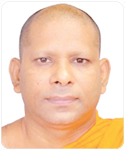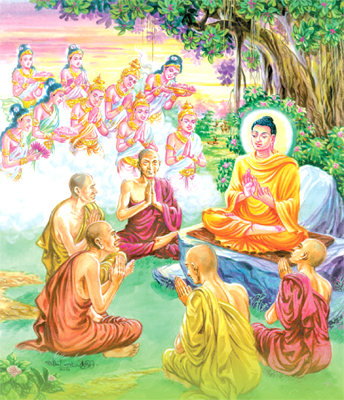The First Dhamma Sermon
Of The Buddha
 Senior Lecturer, Pandit, Senior Lecturer, Pandit,
Faculty of Humanities and Social Sciences
University of Sri Jayewardenepura
Dr. Ven. Dodamgoda SumanasaraThero
On the Esala Full Moon Day, the Buddha delivered his first Dhamma Sermon, the
Dhammacakkappavattana Sutta to the five ascetics namely, Kondanna, Vappa,
Bhaddiya, Mahanama, and Assaji who were at the Deer Park in Isipatana, Banaras,
India.
Prince Siddhartha attained Buddhahood after six years of rigorous practices and
experience in the forest where he continuously practised insight meditation to
realize the reality of life.
As a result of being born again and again in the cycle of continuity (samsara)
he experienced diverse mundane hindrances which led to a sorrowful life. So
that, he was thoroughly determined to eradicate whole obstructions with a full
understanding of the reality of life to find out the solution for suffering.
Consequently, the great teacher, the Buddha delivered his first Dhamma discourse
(the Dhammacakkappavattana Sutta) after the two months of his Enlightenment to
reveal the right path to liberate human beings from worldly suffering (dukkha).
The Pali term “Dhammacakka” means “The Kingdom of Truth”, “The Wheel of Truth”,
and “The Kingdom of Righteousness”. According to the commentators “Dhamma” means
‘Wisdom’ or ‘Knowledge’ and “Cakka” means ‘founding’ or ‘establishment’. Similar
to this meaning “Dhamma and Cakka’’ may also be interpreted as ‘Truth and Wheel.
Accordingly, the meaning of “Dhammacakkappavattana’ is ‘The Exposition of The
Establishment of Wisdom’.
 As the Buddha has mentioned at the beginning of the Dhammacakkappavattana Sutta,
a person who renounces the world should not follow two extremes (ubho anta) such
as self-indulgence (kamasukhallikanuyogaya) and self-mortification (attakilamathanuyogaya)
because this self- indulgence leads people to attach to sensual pleasures. As the Buddha has mentioned at the beginning of the Dhammacakkappavattana Sutta,
a person who renounces the world should not follow two extremes (ubho anta) such
as self-indulgence (kamasukhallikanuyogaya) and self-mortification (attakilamathanuyogaya)
because this self- indulgence leads people to attach to sensual pleasures.
So, the Buddha preaches not to be bound by these sensual pleasures as they are
base, common, vulgar, unholy, and profitless. Also, the Buddha explains why one
should not follow the other end of self-mortification; because it is painful,
unholy, profitless, and useless. Finally, it causes only an increase in
suffering and pain as well as makes people weak mentally and physically. So,
both these ends do not lead the Dhamma followers to get rid of suffering in this
existence and in the following births as well. Further, he states that someone
who follows the two extremes may encounter unhappiness and may not be able to
get rid of feelings, sorrows, and suffering in the mundane life. The Buddha
criticized both these ends and their uselessness since he realized this through
his personal experience throughout his six years as an ascetic. Instead, he has
shown his disciples a more practicable, rational and novel path that leads to
the Absolute Truth.
As the Buddha expounds in the sutta, the Middle Path (majjhima patipada) is the
most important and the only way to follow to gain wisdom and knowledge to
understand the reality of life. Also, the Noble Eightfold Path (ariyo atthangiko
maggo) shows the right way for the Dhamma followers to liberate themselves from
all suffering and secession of sorrow and unhappiness in worldly life.
As well as it may lead the Dhamma followers to purify their minds from all
defilements. Eventually, doing meditation the disciples of the Buddha may be
able to concentrate their minds to attain the stages of the first, second,
third, and fourth sainthood and finally Arahanthship. Therefore, each person
should follow the following Eightfold Path to obtain eternal happiness in life.
1. Right view (Samma ditthi)
2. Right thought (Samma sankappa)
3. Right speech (Samma vaca)
4. Right action (Samma kammanta)
5. Right livelihood (Samma ajiva)
6. Right effort (Samma vayama)
7. Right mindfulness (Samma sati)
8. Right concentration (Samma samadhi)
To understand further, the reality of life and the nature of the body people
should essentially study The Four Noble Truths (Cattari Ariyasaccani). Also, it
can be described as the heart of the Buddha’s teaching. According to the
Dhammacakkappavattana Sutta, the Four Noble Truths can be categorized as
follows:
1. Suffering (Dukkha Ariyasacca)
2. The arising of suffering
(Samudaya Ariyasacca)
3. The cessation of suffering
(Nirodha Ariyasacca)
4. The way leading to the cessation of suffering (Magga Ariyasacca)
The Noble Truth of Suffering tells us about how people suffer and undergo pain
physically and mentally in day-to-day life throughout life due to vivid reasons.
Suffering may form in three ways such as ordinary suffering (dukkha dukkha),
suffering produced by change (viparinama dukkha), and conditioned states (samkhara
dukkha).
This ordinary suffering or pain arises in life due to “birth, old age, sickness,
death, association with unpleasant people and conditions, separation from loved
ones and pleasant conditions, not getting what one desires, grief, lamentation,
and distress.” Viparinama dukkha can happen due to changing of the elements of
the body, happy feelings, and happy condition in life. By the combination of the
five aggregates (pancakkhandha) such as the Aggregate of Matter, the Aggregate
of Sensations, the Aggregate of Perceptions, the Aggregate of Mental Formations,
and the Aggregate of Consciousness form temporarily a ‘being’, or an
‘individual’ or ‘I’. These five aggregates of physical and mental forces
constantly change and produce pain or suffering for all. So, it is known as
Sankkhara dukkha.
The main cause of suffering in the mind is craving (tanha) which leads to the
re-existence of human beings. Craving can be categorized into three parts such
as kama-tanha (thirst for sense pleasures), bhava-tanha (thirst for existence
and becoming), and vibhava-tanha (thirst for non- existence). Accordingly, this
craving smoothly produces rebirth after the death of people. To destroy
suffering in life one needs to annihilate the principal root of suffering i.e.,
craving (tanha). It is known as the cessation of suffering.
According to the Buddha’s teaching the way leading to the cessation of suffering
is the Middle Path (Majjhima Patipada) as it avoids both ends (anta) of
self-mortification and self-indulgence. The Noble Eightfold Path (Ariyo
atthangiko mlaggo) which gives the people vision and knowledge to reach eternal
happiness (Nibbana) by annihilating all composes of suffering of the life.
To conclude, as true followers of the Buddha, we must follow the Eightfold Path
in order to annihilate all desire (raga), hatred (dosa), and delusion (moha) and
put an end to suffering by attaining the bliss of Nibbana. |
